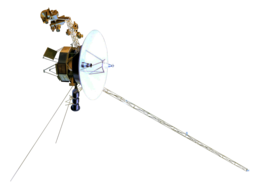Voyager 2
Voyager 2 is a space probe. It was used by NASA to explore Jupiter, Saturn, Uranus, and Neptune. It is the only spacecraft that has come near to Uranus and Neptune. Because of this, most pictures of these two ice planets are from this spacecraft. It was identical in form to its sister space probe, Voyager 1. The space probe is currently moving away from the Solar System. It is heading out into interstellar space.
 Model of the Voyager spacecraft design | |
| Mission type | Planetary exploration |
|---|---|
| Operator | NASA / JPL[1] |
| COSPAR ID | 1977-076A[2] |
| SATCAT no. | 10271[3] |
| Website | voyager |
| Mission duration | 47 years, 4 months and 22 days elapsed Planetary mission: 12 years, 1 month, 12 days Interstellar mission: 35 years, 3 months and 9 days elapsed (continuing) |
| Spacecraft properties | |
| Manufacturer | Jet Propulsion Laboratory |
| Launch mass | 825.5 kilograms (1,820 lb) |
| Power | 470 watts (at launch) |
| Start of mission | |
| Launch date | August 20, 1977, 14:29:00 UTC |
| Rocket | Titan IIIE |
| Launch site | Cape Canaveral LC-41 |
| Flyby of Jupiter | |
| Closest approach | July 9, 1979, 22:29:00 UTC |
| Distance | 570,000 kilometers (350,000 mi) |
| Flyby of Saturn | |
| Closest approach | August 26, 1981, 03:24:05 UTC |
| Distance | 101,000 km (63,000 mi) |
| Flyby of Uranus | |
| Closest approach | January 24, 1986, 17:59:47 UTC |
| Distance | 81,500 km (50,600 mi) |
| Flyby of Neptune | |
| Closest approach | August 25, 1989, 03:56:36 UTC |
| Distance | 4,951 km (3,076 mi) |
Voyager 2 was launched on August 20, 1977. It is now in an extended mission. Its encounter with the largest natural satellite of Neptune, Triton sent it on a hyperbolic trajectory out of the Solar System. It was moving at about 16.62 km/s (37,200 mph; 59,800 km/h). This is much faster than escape velocity.
Both Voyager 1 and Voyager 2 hold the Voyager Golden Record. This is a recording of sounds and images of life on Earth. It was designed by a team led by Carl Sagan. The Golden Record is to communicate with extraterrestrial life.
Voyager 2 is the second spacecraft to exit from the Solar System and enter into the interstellar space. It did so 6 years after Voyager 1. In 2018, NASA said that Voyager 2 had reached the heliopause on 5 November 2018.[4] On July 18, 2023, Voyager 2 overtook Pioneer 10 to become the 2nd farthest spacecraft from the Sun, at a distance of 133.917 AU (nearly 12.45 billion miles or approximately 2034.00 billion km) from the Sun. [5] [6]
Related pages
changeReferences
change- ↑ "VOYAGER:Mission Information". NASA. 1989. Archived from the original on February 20, 2017. Retrieved January 2, 2011.
- ↑ "Voyager 2". US National Space Science Data Center. Archived from the original on March 20, 2009. Retrieved August 25, 2013.
- ↑ "VOYAGER 2". N2YO. Retrieved August 25, 2013.
- ↑ "NASA's Voyager 2 Probe Enters Interstellar Space". NASA Jet Propulsion Laboratory. 10 December 2018. Archived from the original on 14 December 2018. Retrieved 14 December 2018.
- ↑ "Distance between the Sun and Voyager 2".
- ↑ "Distance between the Sun and Pioneer 10".
Other websites
change- NASA Voyager website
- Voyager Spacecraft Lifetime
- Voyager 2 Mission Profile Archived 2007-08-01 at the Wayback Machine by NASA's Solar System Exploration
- Spacecraft Escaping the Solar System Archived 2007-04-27 at the Wayback Machine - current positions and diagrams
- Mission state
- VOYAGER RECENT 6-HOUR HISTORY Archived 2007-06-18 at the Wayback Machine
- Voyager 2 Detects Odd Shape of Solar System's Edge 23 May 2006